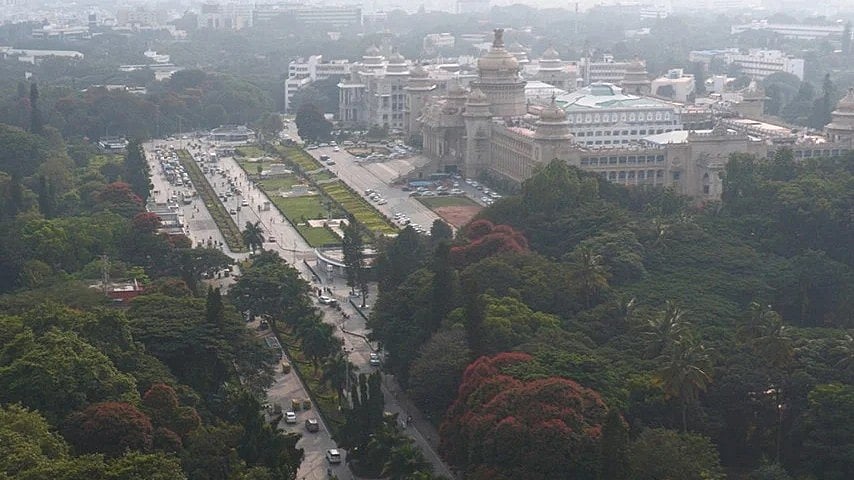
View of Bengaluru city.
Credit: DH Photo
The ‘war of all against all’ that the roads in Bengaluru have triggered recently turned into a war of words between the city’s bourgeoisie and its political class. Why, in a city bristling with scientific expertise, highly motivated and informed urban change activists, are there no political takers for their clearly outlined solutions? The bourgeoisie (entrepreneurs, media professionals, lawyers, technical experts, financiers, and even educators who enable a capitalist mode of production) blame the predicament on the political class for a ‘lack of will’, and Bengalureans’ lack of ‘civic pride’. Deputy Chief Minister D K Shivakumar’s response reminded Kiran Mazumdar-Shaw of his duty towards democracy, but also attributed both the problems and solutions to god.
Both of them would do well to take a course on Modern City 101. Why has the Indian city become the site of squalor and inefficiency, unable to solve basic problems? Lewis Mumford, that brilliant historian of the city, described the horrors of the Victorian city in the first half of the 19th century: the world’s first industrialisation was underway, the railways tore through the fabric of the city, and the industrial slum came into being. Capitalism’s very survival was at stake. But the ‘disease produced its own antibodies’. By the late 19th century, there was new statist intervention in housing, transportation, and in controlling effluents and noxious gases. The problems produced a whole new discipline – urban planning. And some of these solutions saw the active involvement of the bourgeoisie in the form of concessions made to the working poor. The public park arose from such largesse.
In Bengaluru, the disease has not produced antibodies, since the bourgeoisie has chosen not to transform the city they inhabit and share, but to withdraw from it. The gated enclave epitomises the private promise of planning, which has monumentally failed as a public/statist good. It is an example of how capitalism makes its peace with – even benefits from – grotesque inequalities. The road may be their only encounter with democracy.
But why is there in Indian society such widespread unconcern about garbage/public cleanliness, order on the streets, and disrespect for the needs of others? This takes us beyond the economic to the social. We have no shared understanding of the ‘public’, and what might sustain and nurture spaces and facilities for the use and enjoyment of all equally. For one, steep inequalities make one person’s comfortable footpath another person’s livelihood. Likewise, the road is a space available for multiple public uses, not for cars alone. Pandals are installed across streets for festivals, weddings, or any other events; roads are dug up and blocked by private parties. Cacophony is exercised as a right.
The city as a public asset
But perhaps what we need to acknowledge are the hard-wired habits of caste that have taught Indians that they are not responsible for the waste they produce. Swachch Bharat’s spectacular failures arise from the refusal to acknowledge and tackle this deep-seated distaste, across all classes, for cleaning up one’s own mess. Why do all pourakarmikas come from specific castes for whom cleaning has long been their exclusive burden? Japanese school children – including tots – spend their lunch breaks cleaning their toilets. Imagine the moral panic and hysteria that such an idea will create here.
So, hand-wringing apart, what is to be done? Bengaluru has an opportunity to blaze new trails, but they will not be the bourgeoisie’s preferred resolutions. The city has to be seen as a public asset serving the largest number of people, and not car owners alone. No god can ensure this. The State can.
The answer is not in creating more road surfaces or tunnels, but in reducing (private) automobile usage. Odd-even, until the public transport system is strengthened. Neither those who argue ‘Do You Know Who I Am?’ or ‘We Are Like That Only’ should be spared fines for violating municipal rules and traffic laws. It is wiser to rely on bribe-proof mechanical measures for traffic and crowd control: resident parking permits, parking meters, work-from-home days, walk-from-home days, staggered office and school timings, and strictly pedestrian zones. Quadrupled municipal taxes, systems of public accountability, and the slow, painful but urgent task of cultivating shared values of empathy, compassion, and tolerance among young Indians.
All this calls for nothing less than a revolution. But it won’t be the bourgeois revolution that some may want.
(The writer is a retired professor, Jawaharlal Nehru University)